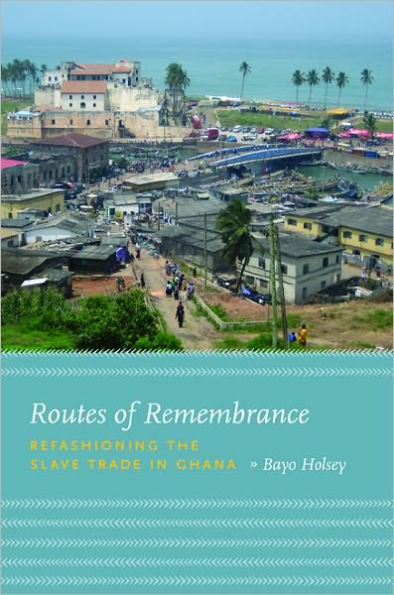Over the past fifteen years, visitors from the African diaspora have flocked to Cape Coast and Elmina, two towns in Ghana whose chief tourist attractions are the castles and dungeons where slaves were imprisoned before embarking for the New World. This desire to commemorate the Middle Passage contrasts sharply with the silence that normally cloaks the subject within Ghana. Why do Ghanaians suppress the history of enslavement? And why is this history expressed so differently on the other side of the Atlantic?
Routes of Remembrance tackles these questions by analyzing the slave trade’s absence from public versions of coastal Ghanaian family and community histories, its troubled presentation in the country’s classrooms and nationalist narratives, and its elaboration by the transnational tourism industry. Bayo Holsey discovers that in the past, African involvement in the slave trade was used by Europeans to denigrate local residents, and this stigma continues to shape the way Ghanaians imagine their historical past. Today, however, due to international attention and the curiosity of young Ghanaians, the slave trade has at last entered the public sphere, transforming it from a stigmatizing history to one that holds the potential to contest global inequalities.
Holsey’s study will be crucial to anyone involved in the global debate over how the slave trade endures in history and in memory.
"1101010018"
Routes of Remembrance tackles these questions by analyzing the slave trade’s absence from public versions of coastal Ghanaian family and community histories, its troubled presentation in the country’s classrooms and nationalist narratives, and its elaboration by the transnational tourism industry. Bayo Holsey discovers that in the past, African involvement in the slave trade was used by Europeans to denigrate local residents, and this stigma continues to shape the way Ghanaians imagine their historical past. Today, however, due to international attention and the curiosity of young Ghanaians, the slave trade has at last entered the public sphere, transforming it from a stigmatizing history to one that holds the potential to contest global inequalities.
Holsey’s study will be crucial to anyone involved in the global debate over how the slave trade endures in history and in memory.
Routes of Remembrance: Refashioning the Slave Trade in Ghana
Over the past fifteen years, visitors from the African diaspora have flocked to Cape Coast and Elmina, two towns in Ghana whose chief tourist attractions are the castles and dungeons where slaves were imprisoned before embarking for the New World. This desire to commemorate the Middle Passage contrasts sharply with the silence that normally cloaks the subject within Ghana. Why do Ghanaians suppress the history of enslavement? And why is this history expressed so differently on the other side of the Atlantic?
Routes of Remembrance tackles these questions by analyzing the slave trade’s absence from public versions of coastal Ghanaian family and community histories, its troubled presentation in the country’s classrooms and nationalist narratives, and its elaboration by the transnational tourism industry. Bayo Holsey discovers that in the past, African involvement in the slave trade was used by Europeans to denigrate local residents, and this stigma continues to shape the way Ghanaians imagine their historical past. Today, however, due to international attention and the curiosity of young Ghanaians, the slave trade has at last entered the public sphere, transforming it from a stigmatizing history to one that holds the potential to contest global inequalities.
Holsey’s study will be crucial to anyone involved in the global debate over how the slave trade endures in history and in memory.
Routes of Remembrance tackles these questions by analyzing the slave trade’s absence from public versions of coastal Ghanaian family and community histories, its troubled presentation in the country’s classrooms and nationalist narratives, and its elaboration by the transnational tourism industry. Bayo Holsey discovers that in the past, African involvement in the slave trade was used by Europeans to denigrate local residents, and this stigma continues to shape the way Ghanaians imagine their historical past. Today, however, due to international attention and the curiosity of young Ghanaians, the slave trade has at last entered the public sphere, transforming it from a stigmatizing history to one that holds the potential to contest global inequalities.
Holsey’s study will be crucial to anyone involved in the global debate over how the slave trade endures in history and in memory.
29.99
In Stock
5
1

Routes of Remembrance: Refashioning the Slave Trade in Ghana
272
Routes of Remembrance: Refashioning the Slave Trade in Ghana
272Related collections and offers
29.99
In Stock

Product Details
| ISBN-13: | 9780226349770 |
|---|---|
| Publisher: | University of Chicago Press |
| Publication date: | 09/15/2008 |
| Sold by: | Barnes & Noble |
| Format: | eBook |
| Pages: | 272 |
| File size: | 943 KB |
About the Author
From the B&N Reads Blog
